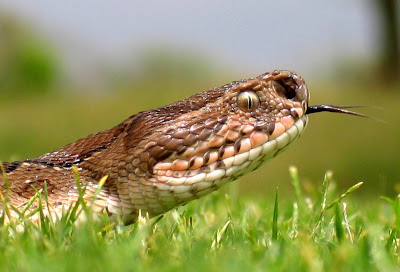The Life of Animals | Daboia | Daboia is a monotypic genus of venomous Old World viper. The single species, D. russelii, is found in Asia throughout the Indian subcontinent, much of Southeast Asia, southern China and Taiwan. The species was named in honor of Patrick Russell (1726–1805), a Scottish herpetologist who first described many of India's snakes; and the genus is after the Hindi name meaning "that lies hid", or "the lurker." This snake can grow to a maximum length of 166 cm (5.5 ft) and averages about 120 cm (4 ft) on mainland Asian populations, although island populations do not attain this size. Ditmars (1937) reported the following dimensions for a "fair sized adult specimen"
The head is flattened, triangular and distinct from the neck. The snout is blunt, rounded and raised. The nostrils are large, in the middle of a large, single nasal scale. The supranasal has a strong crescent shape and separates the nasal from the nasorostral anteriorly. The supraocular scales are narrow, single, and separated by 6–9 scales across the head. The eyes are large, flecked with yellow or gold, and each is surrounded by 10–15 circumorbital scales. There are 10–12 supralabials, the 4th and 5th of which are significantly larger. There are two pairs of chin shields, the front pair of which are notably enlarged. The fangs attain a length of 16 mm in the average specimen. The dorsal scales are strongly keeled; only the lower row is smooth. Mid-body, the dorsal scales number 27–33. The ventral scales number 153–180. The tail is short — about 14% of the total body length — with the paired subcaudals numbering 41–68 The color pattern consists of a deep yellow, tan or brown ground color, with three series of dark brown spots that run the length of its body. The dorsal spots, which usually number 23–30, may grow together, while the side spots may break apart. Behind the eye, there is a dark streak, outlined in white, pink or buff. The venter is white, whitish, yellowish or pinkish, often with an irregular scattering of dark spots.
The snake is mostly found in open, grassy or bushy areas, but may also be found in second growth forests (scrub jungles), on forested plantations and farmland. Terrestrial and active primarily as a nocturnal forager. The identity of this sensor is not certain, but the nerve endings in the supranasal sac of these snakes resemble those found in other heat-sensitive organs. The quantity of venom produced by individual specimens is considerable. Reported venom yields for adult specimens range from 130–250 mg to 150–250 mg to 21–268 mg. For 13 juveniles with an average length of 79 cm, the average venom yield was 8–79 mg (mean 45 mg) The LD50 in mice, which is used as a general indicator of snake venom toxicity, is as follows: 0.08–0.31 μg/g intravenous, 0.40 μg/kg intraperitoneal, 0.75-1.6 mg/kg subcutaneous For most humans, a lethal dose is approximately 40–70 mg. Venom toxicity and bite symptoms in humans varies within different populations and over time Envenomation symptoms begin with pain at the site of the bite, immediately followed by swelling of the affected extremity. Blistering occurs at the site of the bite, developing along the affected limb in severe cases. Necrosis is usually superficial and limited to the muscles near the bite, but may be severe in extreme cases. Vomiting and facial swelling occurs in about one-third of all cases Kidney failure (renal failure) also occurs in approximately 25-30 percent of untreated bites. Severe disseminated intravascular coagulation also can occur in severe envenomations.
If swelling up to the trunk occurs within 1–2 hours, massive envenomation is likely. Discoloration may occur throughout the swollen area as red blood cells and plasma leak into muscle tissue Death from septicaemia, kidney, respiratory or cardiac failure may occur 1 to 14 days post-bite or even later This test is often referred to as Dilute Russell's viper venom time (dRVVT). The coagulant in the venom directly activates factor X, which turns prothrombin into thrombin in the presence of factor V and phospholipid. The venom is diluted to give a clotting time of 23 to 27 seconds and the phospholipid is reduced to make the test extremely sensitive to phospholipid. The dRVVT test is more sensitive than the aPTT test for the detection of lupus anticoagulant (an autoimmune disorder), because it is not influenced by deficiencies in clotting factors VIII, IX or XI In India, the Haffkine Institute prepares a polyvalent antivenin that is used to treat bites from this speciesAt birth, juveniles are 215–260 mm in length.












